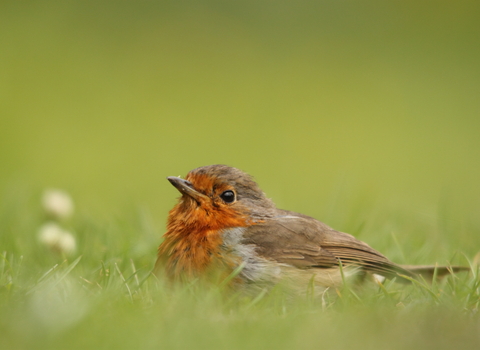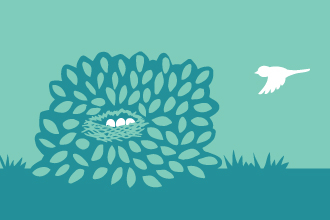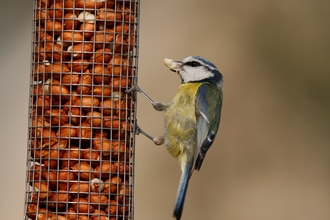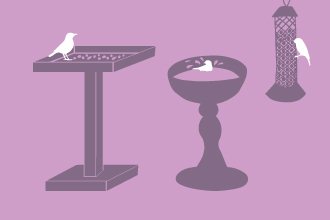Should you help an injured bird?
This page will help advise you on whether you should try to help an injured bird, what to do, and who to contact if you come across one. The Wildlife Trusts do not offer a general service for care and rehabilitation of sick or injured animals, although some individual Trusts may offer local services. Many well-intentioned rescue efforts are unnecessary, and can be more damaging than helpful, so before intervening, ask yourself the following questions:
Is it a baby bird?
Visit our advice page on baby birds for more information.
If it has no feathers it’s a nestling and should be (gently!) put back in the nest if you can see it. Contact an animal welfare organisation if you can’t see the nest, or if the parents do not return to the nest within an hour (links at the bottom of this page).
If it has feathers, it is a fledgling, and it is normal for them to spend a few days on the ground. Fledglings should be left alone unless they are in immediate danger and can be moved to a sheltered spot nearby e.g. under a hedge. It should fly away in a couple of days when its wings are fully developed!
Parents will not abandon baby birds because they have been touched by humans. While rushing in to save every lone baby bird you come across isn't recommended, and survival rates are low, sometimes intervention can save a life.
Is intervention the best course?
Consider the risks and benefits of capture and treatment carefully before attempting to catch the bird. Birds suffer from shock easily, and the stress of being handled can result in death. Only help if it’s unlikely the bird will survive on its own in the wild.
Where did you find it?
Make a note of exactly where you found the injured bird. The end goal of catching and rehabilitating an animal should always be to return it to the wild, so it's important to make sure that it can be released in the right location.
If you strike a bird with your car: Make sure it’s safe before getting out of your vehicle. The casualty may have serious injuries and will need urgent expert attention. Pick it up carefully.
If the bird has flown into a window: Let it rest in a dark space for a few hours. It is possible that it has internal injuries or is concussed, so during this time the bird will either recover or will die from its injuries.
If your cat brought a bird home: You need to act quickly. Birds bitten by cats are at risk of septicaemia (blood poisoning), and without antibiotic treatment are likely to die. Even if the bird seems unscathed, it only takes a small scratch, and it is important to act fast, getting treatment for the casualty within 4 hours if possible.
Is it able to fly?
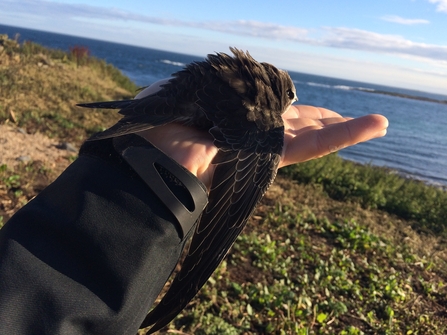
Don't try to launch a grounded swift without contacting a swift carer. Image: © Tom Hibbert
Approach the bird. Birds with minor or leg injuries will usually fly away. If it does, don't try to catch it, but if it doesn’t try to or can’t fly away then you may try to help it.
There is a myth that swifts cannot take off from the ground, but this isn’t true! A healthy adult swift can use its wings to launch into the air, as long as it has enough open space around it. Any swift found on the floor is likely to be exhausted, dehydrated or injured. As swifts are hard to care for, the best thing to do is consult a specialist swift carer. Never try to throw a swift into the air, as it may fall again and cause further injury.
Are you prepared to catch and handle the bird?
If you decide to catch the bird, take care. They have hollow, delicate bones, so improper handling can cause injury easily. Be firm, but gentle and be aware that even the tiniest tit may bite! Below are some things to consider before attempting to catch the bird.
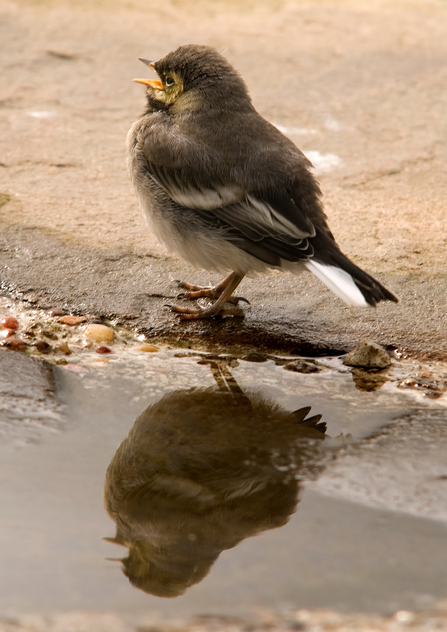
Make sure your "injured bird" is not a fledgling. It is normal for fledglings to spend a few days on the ground, and their parents are usually nearby keeping a watchful eye. © Bob Coyle
Handling and care
Having answered the questions above, if you have decided to intervene, here are some things to consider in preparing to catch, handle and care for the bird while you seek expert advice. Take care!
Birds will usually be more comfortable with their wings held against their bodies, feet supported. Think about the size of the bird before you attempt to handle it:
- Small birds: Can be firmly held in one hand, positioning the hand over the bird so that its head is between your fore and middle fingers, letting the rest of your fingers naturally wrap around the wings.
- Medium birds: Use two hands, each covering a wing.
- Large birds: It is best to call an expert rescuer as larger birds are capable of inflicting some damage to anyone trying to handle them.
Choose an adequately sized box so that the bird can move around, line it with tissues, and make sure it has a cover and air holes. Keeping the bird in the dark helps reduce stress, and a source of heat can help with shock. You can wrap a hot water bottle in a towel and place it inside or next to the box, making sure the bird can get away from the heat if it wants to. If it begins to pant, remove the heat source immediately. Don’t offer food or water without being advised by an expert to do so.
What to do next
If you are unsure about what to do, or are unable to get the casualty specialist care within an hour or two, speak to an animal welfare organisation like the RSPCA for advice. Wildlife rescue services usually can't offer pick up, so you may need to transport the casualty yourself. Make sure you wash your hands well after handling any animal!
Vets aren't obliged to treat wildlife for free, and typically aren't trained in the care of wildlife, so it is a good idea to call around local practices before visiting, and find out if your vet has links with local wildlife rescue groups to make sure the animal is taken care of after being treated.
The RSPCA (SSPCA for Scotland, or the USPCA for Northern Ireland) and Help Wildlife's pages carry more detailed advice on what to do with injured birds and other wildlife. Help Wildlife also have a useful map to help find your local wildlife rescue service.

